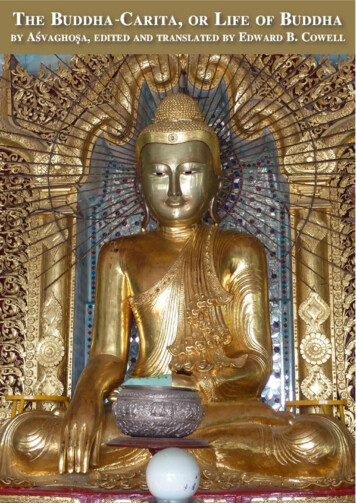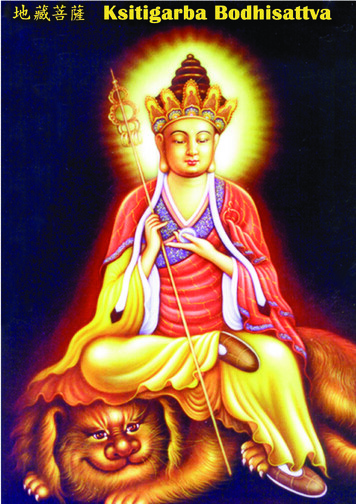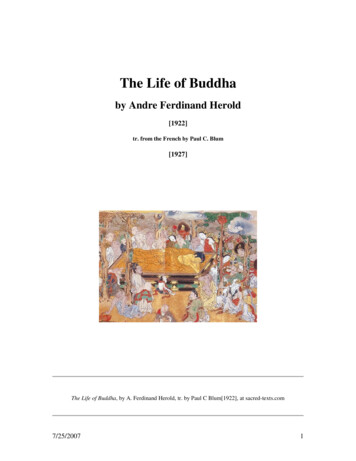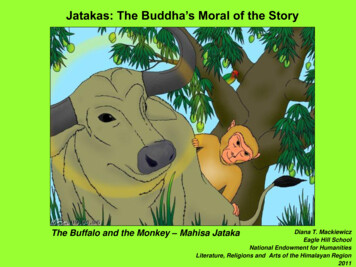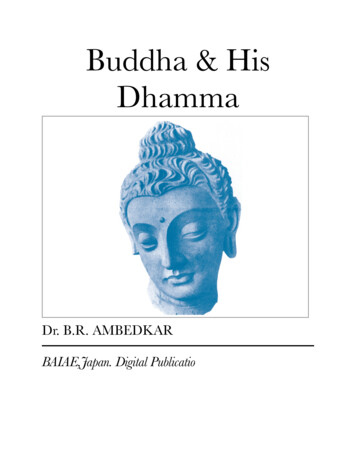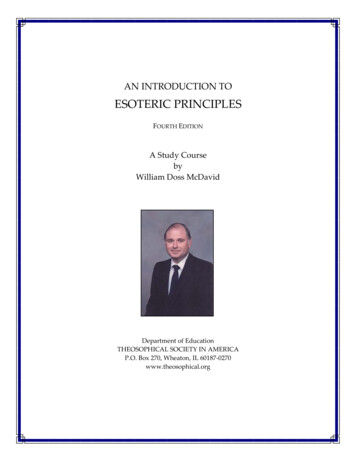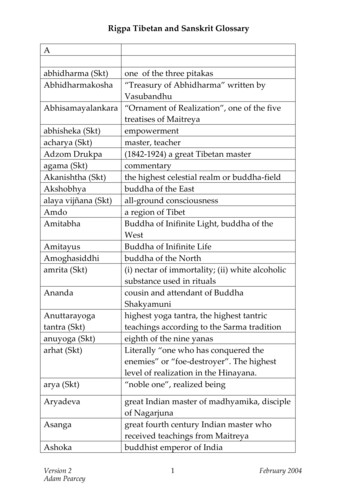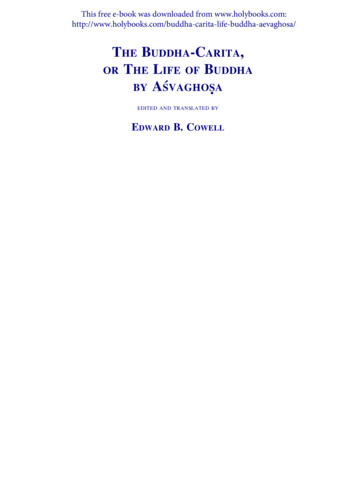
Transcription
This free e-book was downloaded from carita-life-buddha-aevaghosa/The Buddha-Carita,or The Life of Buddhaby Aèvaghoùaedited and translated byEdward B. Cowell
Table of Contents (detail)Preface.3Introduction.4Book I: [Bhagavatprasåtiþ].7Book II: [Antaþpuravihàro].24Book III: [Saüvegotpattiþ].34Book IV: [Strãvighàtano].45Book V: [Abhiniùkramaõo].60Book VI: [Chaüdakanivartanaü].75Book VII: [Tapovanapraveèo].85Book VIII: [Aütaþpuravilàpo].95Book IX: [Kumàrànveùaõo].110Book X: [øreõyàbhigamano].125Book XI: [Kàmavigarhaõo].132Book XII: [Aràóadarèano].145Book XIII: [Màravijayo].163Book XIV.1752
PrefaceThe text and translation of Buddhacarita presented here is for the most part thatprinted in The Buddhacarita or Life of Buddha by Aèvaghoùa, which was edited andtranslated by Professor Edward B. Cowell (first published in 1894 [text] & 1895[translation], reprinted together New Delhi, 1977). The readings and translation havebeen supplemented by E.H. Johnson's text and translation entitled Aèvaghoùa'sBuddhacarita or Acts of the Buddha (first published in Lahore, 1936; reprinted Delhi,1995).The Sanskrit text has been made from a database prepared by Peter Schreiner inFebruary 1990, which contained the pausa form of both Cowell's and Johnson's texts inASCII format, which I have converted to normal diacritics (the diactrical systememployed is described below). I hope at a later date to prepare a text with the pausaform analysis included, which will be a help to students studying the text.The text and translation presented here represents the first fourteen chapters ofAèvaghoùa's text, with the beginning supplemented by the spurious verses found at thebeginning of Cowell's edition (presumably by AmÔtànanda), and Johnson's translation(only) from the Tibetan and Chinese sources to round off Chapter Fourteen. Majordiscrepencies between the two editions have been noted and occasionallysupplementary material from Johnson's edition has been included.I have entered Cowell's notes to the translation, as they often provide interesting crossreferences, and I have also prepared his Introduction to the translation of the text. Ihave not entered his notes to the text though, as I hope at a later date to be able tomake a full comparison with Johnson's edition.The text itself has been presented with a metrical analysis elsewhere on this website,and an English only version of the translation, which contains the translation ofAmÔtànanda's supplementary text, which was printed in the Editio Princeps, but whichis omitted here as it throws no light on Aèvaghoùa's original work.The system of transliteration of Eastern scripts that was used in the Sacred Books ofthe East was later felt to have a number of disadvantages to it, and went out of fashionafter the series was completed. Therefore in preparing this book for electronicpublication I have taken the opportunity to update the presentation in this regard to astandard which is most commonly in use, and is in agreement with the other texts usedon this website.ânandajoti BhikkhuAugust 20053
IntroductionThe Sanskrit text of the Buddha-carita was published at the beginning of last year [i.e1893] in the Anecdota Oxoniensia,' and the following English translation is nowincluded in the series Sacred Books of the East.' It is an early Sanskrit poem written inIndia on the legendary history of Buddha, and therefore contains much that is ofinterest for the history of Buddhism, besides its special importance as illustarating theearly history of classical Sanskrit literature.It is ascribed to Aèvaghoùa; and although there were several writers who bore thatname, it seems most probable that our author was the contemparary and spiritualadvisor of Kaniùka in the first century of our era. Hiouen Thsang, who left India in A.D. 645, mentions him with Deva, Nàgàrjuna, and Kumàralabdha, as the four sunswhich illumine the world;'1 but our fullest account is given by I-tsing, who visited Indiain 673. He states that Aèvaghoùa was an ancient author who composed the Alaïkàraèàstra and the Buddha-carita-kàvya, Þ the latter work being of course the presentpoem. Besides these two works he also composed the hymns in honour of Buddha andthe three holy beings Amitàbha, Avalokiteèvara, and Mahàsthàma, which were chantedat the evening service of the monasteries. In the five countries of India and in thecountries of the Southern ocean they recite these poems, because they express a store ofideas and meaning in a few words.'2 A solitary stanza (VIII, 13) is quoted from theBuddha-carita in Ràyamukuña's commentary on the Amarakoùa I, I. 1, 2, and also byUjjvaladatta in his commentary on the Uõàdi-såtras I, 156; and five stanzas are quotedas from Aèvaghoùa in Vallabhadeva's Subhàùitàvali, which bear a great resemblance tohis style, though they are not found in the extant portion of this poem.3The Buddha-carita was translated into Chinese4 by Dharmarakùa in the fifth century,and a translation of this was published by the Rev. S. Beal in the present series [of theSacred Books of the East]; it was also translated into Tibetan in the seventh or eighthcentury. The Tibetan as well as the Chinese version consists of twenty-eighth chapters,and carries down the life of Buddha to his entrance into Nirvàõa and the subsequentdivision of the sacred relics. The Tibetan version appears to be much closer to theoriginal Sanskrit than the Chinese; in fact from its verbal accuracy we can oftenreproduce the exact words of the original, since certain Sanskrit words are alwaysrepresented by the same Tibetan equivalents, as for instance, the prepositions prefixedto verbal roots. I may here express an earnest hope that we may ere long have anedition and translation of the Tibetan version, if some scholar can be found tocomplete Dr. Wendzel's unfinished labour. He had devoted much time and thought tothe work; I consulted him in several of my difficulties, and it is from him that Iderived all my1234Julien's translation, vol ii, p. 214.See M. Fujishama, Journal Asiatique, 1888, p. 425.Professor Peterson has remarked that two stanzas out of the five occur in BhartÔhari's Nãtièataka.We have for the present classed the Buddha-carita with the Mahàyàna Såtras in default ofmore exact information.4
information about the Tibetan renderings. This Tibetan version promises to be of greathelp in restoring the many corrupt readings which still remain in our faulty NepaleseMSS.Only thriteen books of the Sanskrit poem claim to be Aèvaghoùa's composition; the lastfour books are an attempt by a modern Nepalese author to supply the loss of theoriginal. He tells us this honestly in the colophon, Þ having searched for themeverywhere and not found them, four cantos have been made by me, AmÔtànanda, Þthe fourteenth, fifteenth, sixteenth, and seventeenth.' He adds the date 950 of theNepalese era, corresponding to 1830 A. D.; and we have no difficulty in idendifying theauthor. Ràjendralàl Mitra in his Nepalese Buddhist Literature' mentions AmÔtànandaas the author of two Sanskrit treatises and one in Newàrã; he was probably the fatherof the old paõóit of the Residency at Kàñmàõóu, Guõananda, whose son Indrànandaholds the office at present. Dr. D. Wright informs me that the family seem to havebeen the recognised historians of the country, and keepers of the MS. treasures ofsundray temples. The four books are included in this translation as an interestingliterary curiosity. The first portion of the fourteenth book agrees partly with theTibetan and Chinese, and AmÔtànanda may have had access to some imperfect copy ofthis portion of the original; but after that his account is quite independent, and has norelation to the two versions.In my preface to the edition of the Sanskrit text I have tried to show that Aèvaghoùa'spoem appears to have exercised an important influence on the succeeding poets of theclassical period in India. When we compare the descriptions in the seventh book of theRaghuvaüsa of the ladies of the city crowding to see prince Aja as he passes by fromthe Svayaüvara where the princess Bhojyà has chosen him as her husband, with theepisode in the third book of the Buddha-carita (èlokas 13-24); or the description's ofKàma's assault on øiva in the Kumàrasambhava with that of Màra's temptation ofBuddha in the thirteenth book, we can hardly fail to trace some connection. There is asimilar resemblance between the description in the fifth book of the Ràmàyaõa, wherethe monkey Hanumat enters Ràvaõa's palace by night, and sees his wives asleep in theseraglio and their various unconscious attitudes, and in the description in the fifth bookof the present poem where Buddha on the night of his leaving his home for ever seesthe same unconscious sight in his own palace. Nor may we forget that in the Ràmàyaõathe description is introduced as an ornamental episode; in the Buddhist poem it anessential elelment in the story, as it supplies the final impulse which stirs theBodhisattva to make his escape from the world. These different descriptions becameafterwards commonplaces in Sanskrit poetry, like the catalogue of the ships in Greekor Roman epics; but they may very well have originated in connection with definiteincidents in the Buddhist sacred legend.The Sanskrit MSS. of Nepal are always negligently transcribed and abound withcorrupt passages, which it is often very difficult to detect and restore. My printed textleaves many obscure lines which will have to be cleared up hereafter by more skilfulemendations. I have given in the notes to the translation some further emendations ofmy own, and I have also added several happy conjectures which continental scholarshave kindly suggested to me by letter; and I gladly take this opportunity of adding in a5
foot-note some of which I received too late to insert in their proper places.1I have endeavoured to make my translation intelligible to the English reader, but manyof the verses in the original are very obscure. Aèvaghoùa employs all the resources ofHindu rhetoric (as we might well expect if I-tsing is right in ascribing to him an alaïkàra-èàstra'), and it is often difficult to follow his subtil turns of thought andremote allusions; but many passages no doubt owe their present obscurity to undetectedmistakes in the text of our MSS. In the absence of any commentary (except so far asthe diffuse Chinese translation and occasional reference to the Tibetan have suppliedthe want) I have necessarily been left to my own resources, and I cannot fail to havesometimes missed my author's meaning.Pràüèulabhye phale mohàd udbàhur iva vàmanaþ;but I have tried to do my best, and no one will welcome more cordially any light whichothers may throw on the passages I have misunderstood.The edition of the original text was dedicated to my old friend Professor F. MaxMˆller, and it is sincere gratification to me that this translation will appear in the samevolume with similar translations from his pen.E. B. C.Cambridge:Feb 1, 1894.1Dr. von Boehtlingk suggests saujà vicacàra' in VIII, 3, and vilambakeèyo' in VIII, 21, Þtwo certain emendations. Professor Kielhorn would read nabhasy eva' in XIII, 47 for nayaty eva,' and tatraiva nàsãnam Ôùim' in XIII, 50. Professor Bˆhler would read priyatanayas tanayasya' in I, 87, and na tatyàja ca' in IV, 80.6
Buddha-carita, or The Life of BuddhaBook I: [Bhagavatprasåtiþ][The Birth of the Holy One]1èriyaü paràrdhyàü vidadhadvidhàtÔjit tamo nirasyannabhibhåtabhànubhÔt nudannidàghaü jitacàrucaüdramàþ sa vaüdyate 'rhanniha yasya nopamà 1.1*21. That Arhat is here saluted, who has no counterpart, Þ who, as bestowing thesupreme happiness, surpasses (Brahman) the Creator, Þ who, as driving away darkness,vanquishes the sun, Þ and, as dispelling all burning heat, surpasses the beautiful moon.àsãdvièàlonnatasànulakùmyà payodapaüktyeva parãtapàrèvam udagradhiùõyaü gagaõe 'vagàóhaü puraü maharùeþ kapilasya vastu 1.2*2. There was a city, the dwelling-place3 of the great saint Kapila, having its sidessurrounded by the beauty of a lofty broad table-land as by a line of clouds, and itself,with its high-soaring palaces,4 immersed in the sky.sitonnateneva nayena hÔtvà kailàsaèailasya yadabhraèobhàm bhramàdupetàn vahadaübuvàhàn saübhàvanàü và saphalãcakàra 1.3*3. By its pure and lofty system of government it, as it were, stole the splendour of theclouds of Mount Kailàsa, and while it bore the clouds which came to it through amistake, it fulfilled the imagination which had led them thither.5ratnaprabhodbhàsini yatra lebhe tamo na dàridryamivàvakàèam paràrdhyapauraiþ sahavàsatoùàt kÔtasmitevàtiraràja lakùmãþ 1.4*4. In that city, shining with the splendour of gems, darkness like poverty could find noplace; prosperity shone resplendently, as with a smile, from the joy of dwelling withsuch surpassingly excellent ànaü prativeèama èobhàm jagatyadÔùñveva samànamanyatspardhàü svagehairmitha eva cakre 1.5*5. With its festive arbours, its arched gateways and pinnacles,6 it was radiant withjewels in every dwelling; and unable to find any other rival in the world, it could onlyfeel emulation with its own houses.123456The chapter titles are not given by Cowell, and are taken from Johnston's version. There isno head-title in the original, but they can be inferred from the end-title.Verses marked with an asterick are omitted from Johnson's edition as being spurious.Vastu seems to be used here for vàstu.DhiùõyaThey had though that it was KailàsaOr towers? (siühakarõaiþ)7
Buddha-carita, or The Life of Buddharàmàmukheüdån paribhåtapadmàn yatràpayàto 'pyavimanya bhànuþ saütàpayogàdiva vàri veùñuü paècàtsamudràbhimukhaþ pratasthe 1.6*6. There the sun, even although he had retired, was unable to scorn the moon-like facesof its women which put the lotuses to shame, and as if from the access of passion,hurried towards the western ocean to enter the (cooling) water.èakyàrjitànàü yaèasàü janena dÔùñvàütabhàvaü gamito 'yamindraþ iti mivodayacchat 1.7*7. Yonder Indra has been utterly annihilated by the people when they saw the glories1acquired by the Sakyas,'-uttering this scoff, the city strove by its banners with gayfluttering streamers to wipe away every mark of his existence.kÔtvàpi ràtrau kumudaprahàsamiüdoþ karairyadrajatàlayasthaiþ sauvarõaharmyeùu gatàrkapàdairdivà sarojadyutimàlalaübe 1.8*8. After mocking the water-lilies even at night by the moonbeams which rest on itssilver pavilions, Þ by day it assumed the brightness of the lotuses through thesunbeams falling on its golden palaces.mahãbÔtàü mårdhni kÔtàbhiùekaþ èuddhodano nàma nÔpo 'rkabaüdhuþ adhyàèayo và sphuñapudarãkaü puràdhiràjaü tadalaücakàra 1.9*9. A king, by name øuddhodana, of the kindred of the sun, anointed to stand at thehead of earths monarchs, Þ ruling over the city, adorned it, as a bee-inmate a fullblown lotus.2bhåbhÔtparàrdhyo 'pi sapakùa eva pravÔttadàno 'pi madànupetaþ ãèo 'pi nityaü samaóÔùñipàtaþ saumyasvabhàvo 'pi pÔthupratàpaþ 1.10*10. The very best of kings with his train ever near him,3 Þ intent on liberality yetdevoid of pride;4 a sovereign, yet with an ever equal eye thrown on all,5 Þ of gentlenature and yet with wide-reaching majesty.6123456For the genitive yaèasàm, see Pàõ. II, 3. 52 (adhãgartha).Và is used for iva in øièup. Badha, III, 63, IV, 35; Meghad. 82. (Cf. infra, IV, 44.)Puràdhiràjam seems used adverbally. Cf. the line in Vikramorv. kusumàny àèerateshañpadàþ. Could it mean as a thought the lotus of the heart?'Also though the highest of mountains, yet bearing his wings (uncut).'Or if applied to an elephant, not in rut.'Or with a double meaning in ãèa, though like øãva, yet with even eyes,' i.e. not three.Or like the moon, yet widely burning (like the sun).'8
Buddha-carita, or The Life of Buddhabhujena yasyàbhihatàþ pataüto dviùaddvipeüdràþ samaràügaõeùu udvàütamuktàprakaraiþ èirobhirbhaktyeva puùpàüjalibhiþ praõemuþ 1.11*11. Falling smitten by his arm in the arena of battle, the lordly elephants of his enemiesbowed prostrate with their heads pouring forth quantities of pearls as if they wereoffering handfuls of flowers in homage.atipratàpàdavadhåya èatrånmahoparàgàniva tigmabhànuþ udyotayàmàsa janaü samaütàtpradarèayannàèrayaõãyamàrgàn 1.12*12. Having dispersed his enemies by his preeminent majesty as the sun disperses thegloom of an eclipse, he illuminated his people on every side, showing them the pathswhich they were to follow.dharmàrthakàmà viùayaü mitho 'nyaü na veèamàcakramurasya nãtyà vispardhamànà iva tågrasiddheþ sugocare dãptatarà babhåvuþ 1.13*13. Duty, wealth, and pleasure under his guidance assumed mutually each other'sobject, but not the outward dress; yet as if they still vied together they shone all thebrighter in the glorious career of their triumphant success.udàrasaükhyaiþ sacivàirasaükhyaiþ kÔtàgrabhàvaþ sa udagrabhàvaþ èaèã yathà bhairakÔtànyathàbhaiþ èakyeüdraràjaþ sutaràü raràja 1.14*14. He, the monarch of the øàkyas, of native pre-eminence, but whose actual preeminence was brought about by his numberless councillors of exalted wisdom, shoneforth all the more gloriously, like the moon amidst the stars shining with a light like itsown.1tasyàtièobhàvisÔtàtièobhà raviprabhevàstatamaþ prabhàvà samagradevãnivahàgradevã babhåva màyàpagateva màyà 1.15*15. To him there was a queen, named Màyà, as if free from all deceit (màyà) Þ aneffulgence proceeding from his effulgence, like the splendour of the sun when it is freefrom all the influence of darkness, a chief queen in the united assembly of all queens.prajàsu màteva hitapravÔttà gurau jane bhaktirivànuvÔttà lakùmãrivàdhãèakule kÔtàbhà jagatyabhåduttamadevatà yà 1.16*16. Like a mother to her subjects, intent on their welfare, Þ devoted to all worthy ofreverence like devotion itself, Þ shining on her lord's family like the goddess ofprosperity, Þ she was the most eminent of goddesses to the whole world.1Or perhaps shining with its light undimmed by the stars.'9
Buddha-carita, or The Life of Buddhakàmaü sadà strãcaritaü tamisraü tathàpi tàü prapya bhÔèaü vireje na hãüdulekhàmupagamya èubhàü naktaü tathà saütamasatvameti 1.17*17. Verily the life of women is always darkness, yet when it encountered her, it shonebrilliantly; thus the night does not retain its gloom, when it meets with the radiantcrescent of the moon.atãüdriyenàtmani duùkuho 'yaü mayà jano yojayituü na èakyaþ itãva såkùmàü prakÔtiü vihàya dharmeõa sàkùàdvihità svamårtiþ 1.18*18. This people, being hard to be roused to wonder in their souls, cannot be influencedby me if I come to them as beyond their senses,' - so saying, Duty abandoned her ownsubtile nature and made her form visible.cyuto 'tha kàyàttuùitàt trilokãmudyotayannuttamabodhisattvaþ viveèa tasyàþ smÔta eva kukùau naüdàguhàyàmiva nàgaràjaþ 1.19*19. Then falling from the host of beings in the Tuùita heaven,1 and illumining the threeworlds, the most excellent of Bodhisattvas suddenly entered at a thought into herwomb, like the Nàga-king entering the cave of Nandà.dhÔtvà himàdridhavalaü guru ùaóviùàõàüdànàdhivàsitamukhaü dviradasya råpam èuddhodanasya vasudhàdhipatermahiùyàþkukùiü viveèa sa jagadvyasanakùayàya 1.20*20. Assuming the form of a huge elephant white like Himàlaya, armed with six tusks,with his face perfumed with flowing ichor, he entered the womb of the queen of kingøuddhodana, to destroy the evils of the world.rakùàvidhànaü prati lokapàlà lokaikanàthasya divo 'bhijagmuþ sarvatra bhàüto 'pi hi caüdrapàdà bhajaüti kailàsagirau vièeùam 1.21*21. The guardians of the world hastened from heaven to mount watch over the world'sone true ruler; thus the moonbeams, though they shine everywhere, are especiallybright on Mount Kailàsa.mayàpi taü kukùigataü dadhànà vidyudvilàsaü jaladàvalãva dànàbhivarùaiþ parito janànàü dàridryatàpaü èamayàücakàra 1.22*22. Màyà also, holding him in her womb, like a line of clouds holding a lightning-flash,relieved the people around her from the sufferings of poverty by raining showers ofgifts.1For tuùitàt kàyàt, cf. tuùite devanikàya apapannà, Divyàvad. p. 82; and tuùitakàyika, Lalitav.ùaódanta.10
Buddha-carita, or The Life of Buddhasàtaþ purajanà devã kadàcidatha luübinãm jagàmànumate ràjÿaþ saübhåtottamadohadà 1.23*23. Then one day by the king's permission the queen, having a great longing in hermind, went with the inmates of the gynaeceum into the garden Lumbinã.èàkhàmàlaübamànàyàþ puùpabhàràvalaübinãm devyàþ kukùiü vibhidyàèu bodhisattvo viniryayau 1.24*24. As the queen supported herself by a bough which hung laden with a weight offlowers, the Bodhisattva suddenly came forth, cleaving open her womb.tataþ prasannaèca babhåva puùyastasyàèca devyà vratasaüskÔtàyàþ pàrèvàtsuto lokahitàya jajÿe nirvedanaü caiva niràmayaü ca 1.25 (1.9)25. 1At that time the constellation Puùya was auspicious, and from the side of thequeen, who was purified by her vow, her son was born for the welfare of the world,without pain and without illness.pràtaþ payodàdiva tigmabhànuþ samudbhavanso 'pi ca màtÔkukùeþ sphuranmayåkhairvihatàüdhakàraiècakàra lokaü kanakàvadàtam 1.26*26. Like the sun bursting from a cloud in the morning, Þ so he too, when he was bornfrom his mother's womb, made the world bright like gold, bursting forth with his rayswhich dispelled the darkness.taü jàtamàtramatha kàücanayåpagauraüprãtaþ sahasranayaõaþ èanakairagÔhõàtmaüdàrapuùpanikaraiþ saha tasya mårdhnikhànnirmale ca vinipetaturaübudhàre 1.27*27. As soon as he was born the thousand-eyed (Indra) well-pleased took him gently,bright like a golden pillar; and two pure streams of water fell down from heaven uponhis head with piles of Mandàra flowers.surapradhànaiþ paridhàryamàõo dehàüèujàlairanuraüjayaüstàn saüdhyàbhrajàloparisaüniviùñaü navoóuràjaü vijigàya lakùmyà 1.28*28. Carried about by the chief suras, and delighting them with the rays that streamedfrom his body, he surpassed in beauty the new moon as it rests on a mass of eveningclouds.1From this point the Tibetan and Chinese versions agree more or less with the Sanskrit text.[Ed: Johnson's opening in Sanskrit, begins with verse 8, which he gives as: tasminvaneèrãmati ràjapatnau prasutikàlaü samavekùamàõà èayyàü vitànopahitàü prapedenàrãsahasrairabhinandhamànà , and which he translates as follows: In that glorious grovethe queen percieved that the time of her delivery was at hand and, amidst the welcome ofthousands of waiting-women, proceeded to a couch overspread with an awning.']11
Buddha-carita, or The Life of Buddhaåroryathaurvasya pÔthoèca hastànmàüdhàturiüdrapratimasya mårdhnaþ kakùãvataècaiva bhujàüsadeèàttathàvidhaü tasya babhåva janma 1.29 (1.10)29. As was Aurva's birth from the thigh,1 and PÔthu's from the hand,2 and MàndhàtÔ's,who was like Indra himself, from the forehead,3 and Kakùãvat's from the upper end ofthe arm,4 Þ thus too was his birth (miraculous).krameõa garbhàdabhiniþsÔtaþ san babhau gataþ khàdiva yonyajàtaþ kalpeùvanekeùviva bhàvitàtmà yaþ saüprajànan suùuve na måóhaþ 1.30 (1.11)30. Having thus in due time issued from the womb, he shone as if he had come downfrom heaven, he who had not been born in the natural way, Þ he who was born full ofwisdom, not foolish, as if his mind had been purified by countless aeons ofcontemplation.dãptyà ca dhairyeõa èriyà raràja bàlo ravirbhåmimivàvatãrõaþ tathàtidãpto 'pi nirãkùyamàõo jahàra cakùåüùi yathà èaèàükaþ 1.31 (1.12)31. With glory, fortitude, and beauty he shone like the young sun descended upon theearth; when he was gazed at, though of such surpassing brightness, he attracted all eyeslike the moon.sa hi svagàtraprabhayojjvalaütyà dãpaprabhàü bhàskaravanmumoùa mahàrhajàübånadacàruvarõo vidyotayàmàsa dièaèca sarvàþ 1.32 (1.13)32. With the radiant splendour of his limbs he extinguished like the sun the splendourof the lamps; with his beautiful hue as of precious gold he illuminated all the quartersof space.anàkulànyabjasamudgatàni niùpeùavaütyàyatavikramàõi tathaiva dhãràõi padàni sapta saptarùitàràsadÔèo jagàma 1.33 (1.14)33. Unflurried, with the lotus-sign in high relief,5 far-striding, set down with a stamp,Þ seven such firm footsteps did he then take, Þ he who was like the constellation ofthe seven »ùis.12345Mahàbh. I, 2610.Viùõu Pur. I, 13.According to the Mahàbh. III, l.10450, he was born from his father's left side, but cf. ViùõuPur. IV, 2.The MSS. vary between bhujàüèa and bhukàüsa; we might conjecture bhujàgradeèàt, butbhujàüèadeèàt is the only reading in V, 56. Beal I, 10 has the armpit.'Abjasamudgatàni. Cf. Beal I, 16, note.12
Buddha-carita, or The Life of Buddhabodhàya jàto 'smi jagaddhitàrthamaütyà tathotpattiriyaü mameti caturdièaü siühagatirvilokya vàõãü ca bhavyàrthakarãmuvàca 1.34 (1.15)34. I am born for supreme knowledge, for the welfare of the world, Þ thus this is mylast birth,' thus did he of lion gait, gazing at the four quarters, utter a voice full ofauspicious meaning.khàtprasrute caüdramarãcièubhre dve vàridhàre èièiroùõavãrye èarãrasaukhyàrthamanuttarasya nipetaturmårdhani tasya saumye 1.35 (1.16)35. Two streams of water bursting from heaven, bright as the moon's rays, having thepower of heat and cold, fell down upon that peerless one's benign head to giverefreshment to his body.èrãmadvitàne kanakojjvalàüge vaióåryapàde èayane èayànam yadgauravàtkàücanapadmahastà yakùàdhipàþ saüparivàrya tasthuþ 1.36 (1.17)36. His body lay on a bed with a royal canopy and a frame shining with gold, andsupported by feet of lapis lazuli, and in his honour the yakùa-lords stood roundguarding him with golden lotuses in their hands.màyàtanåjasya divaukasaþ khe yasya prabhàvàtpraõataiþ èirobhiþ àdhàrayan pàõdaramàtapatraü bodhàya jepuþ paramàèiùaèca 1.37 (1.18)37. The gods in homage to the son of Màyà, with their heads bowed at his majesty,held up a white umbrella in the sky and muttered the highest blessings on his supremewisdom.mahoragà dharmavièeùatarùàdbuddheùvatãteùu kÔtàdhikàràþ yamavyajan bhaktivièiùñanetrà maüdàrapuùpaiþ samavàkiraüèca 1.38 (1.19)38. The great dragons1 in their great thirst for the Law,2 Þ they who had had theprivilege of waiting on the past Buddhas, Þ gazing with eyes of intent devotion,fanned3 him and strewed Mandàra flowers over him.tathàgatotpàdaguõena tuùñàþ èuddhàdhivàsàèca vièuddhasattvàþ devà nanaüdurvigate 'pi ràge magnasya duþkhe jagato hitàya 1.39 (1.20)39. Gladdened through the influence of the birth of the Tathàgata, the gods of purenatures and inhabiting pure abodes4 were filled with joy, though all passion wasextinguished, for the sake of the world5 drowned in sorrow.12345Mahoragàþ.Cf. infra, èloka 54.Avyajan.øuddhàdhivàsàþ.reading hitàya.13
Buddha-carita, or The Life of Buddhayasmin prasåte giriràjakãlà vàtàhatà nauriva bhåècacàla sacaüdanà cotpalapadmagarbhà papàta vÔùñirgagaõàdanabhràt 1.40 (1.21)40. When he was born, the earth, though fastened down by (Himàlaya) the monarch ofmountains, shook like a ship tossed by the wind; and from a cloudless sky there fell ashower full of lotuses and water-lilies, and perfumed with sandalwood.vàtà vavuþ sparèasukhà manojÿà divyàni vàsàüsyavapàtayaütaþ såryaþ sa evàbhyadhikaü cakàèe jajvàla saumyàrciranãrito 'gniþ 1.41 (1.22)41. Pleasant breezes blew soft to the touch, dropping down heavenly garments; the verysun, though still the same, shone with augmented light, and fire gleamed, unstirred,with a gentle lustre.pràguttare càvasathapradeèe kåpaþ svayaü pràdurabhåtsitàübuþ aütaþ puràõyàgatavismayàni yasmin kriyàstãrtha iva pracakruþ 1.42 (1.23)42. In the north-eastern part of the dwelling a well of pure water appeared of its ownaccord, wherein the inhabitants of the gynaeceum, filled with wonder, performed theirrites as in a sacred bathing-place.dharmàrthibhirbhåtagaõaièca divyaistaddarèanàrthaü balamàpa påraþ kautåhalenaiva ca pàdapaièca prapåjayàmàsa sagaüdhapuùpaiþ 1.43 (1.24)43. Through the troops of heavenly visitants, who came seeking religious merit, thepool itself received strength to behold Buddha, and by means of its trees bearingflowers and perfumes it eagerly offered him worship.puùpadumàþ svaü kusumaü pukulluþ sasãraõodràmitadiksugaüdhi susaübhramadnÔgavadhåpagãtaü bhujaügaüvÔdàpihitàttavàtam 1.44*44. The flowering trees at once produced their blossoms, while their fragrance wasborne aloft in all directions by the wind, accompanied by the songs of bewilderedfemale bees, while the air was inhaled and absorbed by the many snakes (gatheringnear).1kvacit àdibhièca svãõàü calatkuüóalabhåùitànàü viràjitaü cobhayapàrècatastat 1.45*45. Sometimes there resounded2 on both sides songs mingled with musical instrumentsand tabours, and lutes also, drums, tambourines, and the rest, from women adornedwith dancing bracelets.12Serpents are called vàyubhakùa. See Ind. Spruche, III, 4738, and Raghuvaüsa XIII, 12. Cf.also infra, VII, 15.Varàjitam, it was manifested by.' Can that mean then' or there?'14
Buddha-carita, or The Life of Buddhayadràjaèàstraü bhÔguraügirà và na cakraturvaüèakaràvÔùã tau tayoþ sutau tau ca sasarjatustatkàlena èukraèca bÔhaspatièca 1.46 (1.41)46. 1 That royal law which neither BhÔgu nor Aïgiras ever made, those two great seersthe founders of families, their two sons øukra and VÔhaspati left revealed at the end.sàrasvataècàpi jagàda naùñaü vedaü punaryaü dadÔèurna pårvam vyàsastathainaü bahudhà cakàra na yaü vaèiùñhaþ kÔtavànaèaktiþ 1.47 (1.42)47. Yea, the son of Sarasvatã2 I proclaimed that lost Veda which they had never seenin former ages, Þ Vyàsa rehearsed that in many forms, which Vaèiùñha helpless couldnot compile;vàlmãkinàdaèca sasarja padyaü jagraütha yanna cyavano mahàrùiþ cikitsitaü yacca
episode in the third book of the Buddha-carita (èlokas 13-24); or the description's of Kàma's assault on øiva in the Kumàrasambhava with that of Màra's temptation of Buddha in the thirteenth book, we can hardly fail to trace some connection. There is a similar resemblance between the description
